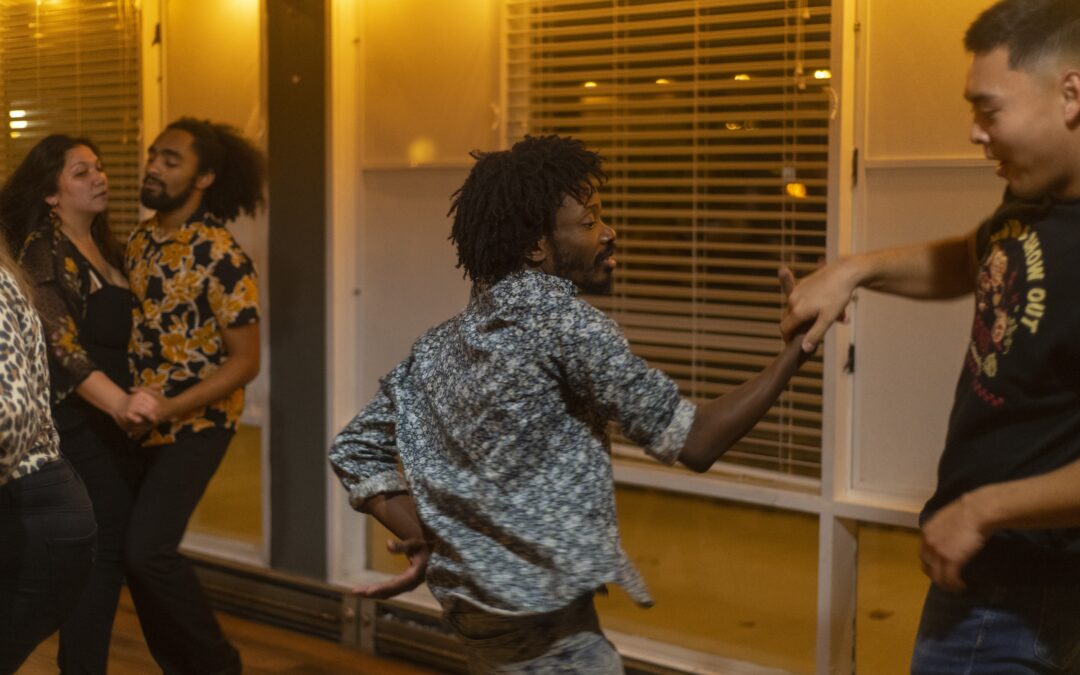(Mentor artist Joshua Purnell, center, and Noah Stovall, left, dance with partners. Tidewater Blues meets every Monday at the Fred Huette Center in Norfolk for blues dance instruction and a social dance.)
Words & Photo By Pat Jarrett
Nationally, the Tidewater region of Virginia is a focal point of Black culture: From contemporary artists like Pharrell Williams and Missy Elliott, to the beach music of the 1950s and ‘60s, to the Afro-Caribbean and gospel traditions, these roots run deep.
Social dancing in the African American community thrived in grand theaters like the Attucks Theater in Norfolk — referred to as the Apollo of the South — to houses all around the region. Neighborhood house parties, record parties, and rent parties inspired the early dancing of modern innovators like Junious Lee Brickhouse. Junious learned to dance from his mother Lynda in the early 1980s, and as a young man danced with City Limits crew, and today is a leader in the House Dance tradition.
Junious learned to dance where the communities gathered. “For young Black children like myself, that meant community centers, parking lots, dance competitions, any place where young people were sharing with each other and building communities around urban dance forms,” he said in a 2019 interview with the Virginia Folklife Program. In 2019 he was a mentor artist in our Apprenticeship Program and in 2022 he received funding from the Library of Congress to continue documenting Black community dance traditions.
Today, Joshua Purnell is carrying on the tradition of black social dancing in Norfolk. The self-described wallflower said dance and rhythm didn’t come naturally to him, but he had a crush on a girl who brought him to a dance night at Tidewater Blues.
“I started jonesing for more dance so then I started going to Attucks Theater up the street, and they taught swing there,” he said. “So then I started learning swing [dance], and then I started learning West Coast, and and then Chicago step, and Latin.” Now, Joshua is one of the organizers of Tidewater Blues.
Tidewater Blues is a social dance group that gathers once a week at the Fred Heutte Center in the Ghent neighborhood of Norfolk of about 30 people. The dances are held on the first floor of the narrow, two-story building in a space big enough to accommodate a small yoga class or a group gathering. It’s the perfect size for blues dancing, said Joshua. The intimacy of sharing a small space and dancing echoes the closeness of blues dancing.
“Sometimes I’ll start by having the students or the dancers rotate and just simply hug each other,” Joshua said. “And wherever you can find a way to connect with your partner, you connect there. And the more that you guys connect, the better you can communicate through the dance.”
It’s a physical conversation without words, sometimes without wide movements, but instead close dancing and smooth glides across the dance floor. The rhythm of the dance is dictated by the music, so slower R&B songs warrant slower movements than the kind of social dances made popular in the legendary dance halls of Harlem, like the Lindy Hop, a dance created at the Savoy Ballroom in the early 20th century.
“You’ll find that that blues dancing was one of the first products of African American culture,” fellow dance organizer Noah Stovall said. He added that when you follow a modern Black dance back to its roots—like break dancing—it often points to blues dance. “[Blues dancing] was a means for my ancestors to just build a community and maintain that community during times where it was very hard to.”
Both Joshua and Noah underscored the lack of formal steps in blues dancing, emphasizing that it’s more so a way to connect with and express the music through close, partnered dancing.
Apprentice and photographer Tom Norris met Joshua to make a portrait, with no intent on joining a dance community, but Joshua invited him to a dance lesson and social after the portrait session. He said he was hooked pretty early on.
“You’re moving physically, you’re feeling that conversation with that person as you’re moving, and you’re listening to the music,” he said. “And have to be in the moment. Don’t focus on whatever is tripping you up. Don’t worry about those things that are making you uncomfortable … You know, you let go and you just go out there and live and enjoy the moment.”
Tidewater Blues meets at the Fred Huette Center in Norfolk on Monday evenings and is free and open to the public. The connections formed between dancers are building blocks to growing this fulfilling movement community. With the tradition of blues dancing at its core, Tidewater Blues, like so many dance groups across the country, nurtures a sense of wellbeing and connectedness. At its roots, as in 2023, moving to the blues has healing benefits.
This article is republished courtesy of Virginia Folklife Program.




